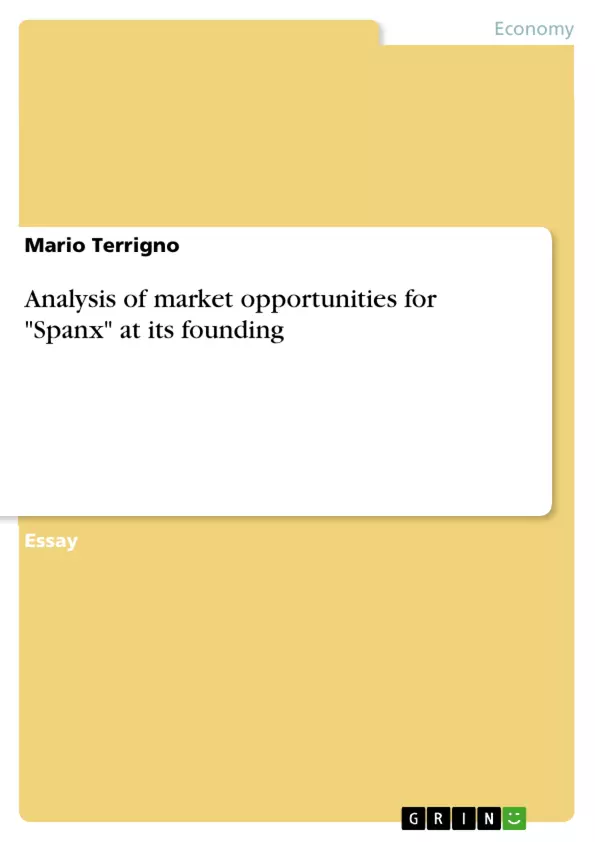Spanx is a company founded in 1998 by Sara Blakely. It manufactures and markets apparel and hosiery products for women through online retailers, department stores and boutiques located across the US, Australia, Canada and the UK. The key products that the company offer include body shapers, bras, panties, slip, tights, and socks.
The peculiarity of this company is due to the unique story of how its founder, who without any business and economic education, managed to launch a billion dollar organization.
The object of this paper is to analyse which market opportunities existed at the time Sara Blakely decide to create her first body shaper and what type of strategy gave her the chance to successfully exploit these opportunities.
Once a detailed assessment will be made, recommendations to new entrepreneurs will be outlined in order to illustrate the importance of the lessons that Spanx’s case can provide to current business challenges.
Table of Contents
- Introduction
- Industry Opportunity
- Market Opportunity
- Team Domain
- Recommendations
Objectives and Key Themes
This paper analyzes the market opportunities that enabled Spanx's success and outlines strategic recommendations for entrepreneurs. It examines how Sara Blakely, without formal business training, built a billion-dollar company.
- Market opportunities in the shapewear industry during the 1990s
- Spanx's unique product and marketing strategy
- The importance of customer relationships and product development
- The role of word-of-mouth marketing
- Spanx's competitive advantages and challenges
Chapter Summaries
Introduction: This introductory chapter sets the stage by introducing Spanx, its founder Sara Blakely, and the overarching goal of the paper – to analyze the market opportunities that propelled Spanx's success and derive actionable recommendations for aspiring entrepreneurs. It highlights Blakely's unconventional path to building a billion-dollar enterprise despite lacking formal business education, emphasizing the case study's potential to offer valuable insights into contemporary business challenges.
Industry Opportunity: This chapter delves into the state of the shapewear industry during the 1990s, revealing a stagnant market perceived as offering limited opportunities. It contrasts this prevailing view with Blakely's insight, showcasing her ability to recognize untapped potential not just in product manufacturing but also in targeting a new customer segment. The chapter underscores the pivotal role of micro-level innovation in transforming a macro-level industry landscape, emphasizing how Spanx's unique value proposition – invisible pantyhose with appealing packaging – shifted the industry's perception and sparked a domino effect.
Market Opportunity: This section examines Spanx's sustained competitive advantage stemming from its novel approach within an established market. It explains how this allowed access to the entire retail industry, targeting a broad customer base eager to enhance their silhouette. A key aspect discussed is Spanx’s independence from marketing and organizational threats, relying on word-of-mouth marketing to achieve remarkable revenue growth ($250 million without advertising), highlighting the product’s inherent virality and customer advocacy.
Team Domain: This chapter focuses on Sara Blakely's personal commitment and its impact on Spanx's development and customer relationships. It details how her own experience as a consumer shaped the product development process, emphasizing the importance of empathetic product design and manufacturing practices. The chapter illustrates how Blakely's close connection to the product led to significant changes in manufacturing operations, including user testing and feedback integration, showcasing a customer-centric approach that distinguished Spanx in the market.
Keywords
Spanx, Sara Blakely, shapewear, market opportunity, product development, customer relationships, word-of-mouth marketing, competitive advantage, retail industry, entrepreneurial strategy, innovation, value proposition.
Spanx Case Study: Frequently Asked Questions
What is this document about?
This document is a comprehensive preview of a case study analyzing the success of Spanx, focusing on the market opportunities that enabled its growth and providing strategic recommendations for entrepreneurs. It examines how Sara Blakely built a billion-dollar company despite lacking formal business training.
What are the key themes explored in the case study?
The key themes include market opportunities in the shapewear industry during the 1990s, Spanx's unique product and marketing strategy, the importance of customer relationships and product development, the role of word-of-mouth marketing, and Spanx's competitive advantages and challenges.
What topics are covered in each chapter?
The Introduction sets the context, introducing Spanx and its founder. The Industry Opportunity chapter analyzes the shapewear market in the 1990s and Spanx's innovative approach. The Market Opportunity chapter examines Spanx's sustained competitive advantage and its reliance on word-of-mouth marketing. The Team Domain chapter focuses on Sara Blakely's personal commitment and its influence on product development and customer relationships.
What are the key takeaways from the case study?
The case study highlights the importance of identifying untapped market potential, developing a unique value proposition, prioritizing strong customer relationships, leveraging word-of-mouth marketing, and understanding the crucial role of empathetic product design in achieving entrepreneurial success. It showcases how micro-level innovation can transform a macro-level industry.
What are the main keywords associated with this case study?
The main keywords include Spanx, Sara Blakely, shapewear, market opportunity, product development, customer relationships, word-of-mouth marketing, competitive advantage, retail industry, entrepreneurial strategy, innovation, and value proposition.
What is the overall objective of the case study?
The objective is to analyze the market opportunities that contributed to Spanx's success and provide actionable recommendations for aspiring entrepreneurs, illustrating how a lack of formal business training didn't hinder the creation of a highly successful enterprise.
What makes this case study valuable?
The case study offers valuable insights into building a successful business by focusing on a real-world example of innovation, market analysis, and entrepreneurial drive. It provides a practical model for aspiring entrepreneurs to learn from.
- Quote paper
- Mario Terrigno (Author), 2017, Analysis of market opportunities for "Spanx" at its founding, Munich, GRIN Verlag, https://www.grin.com/document/351756



